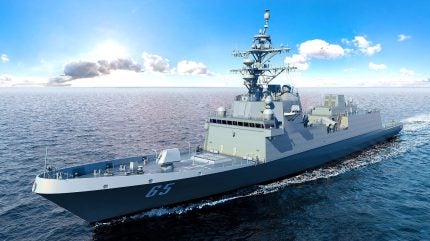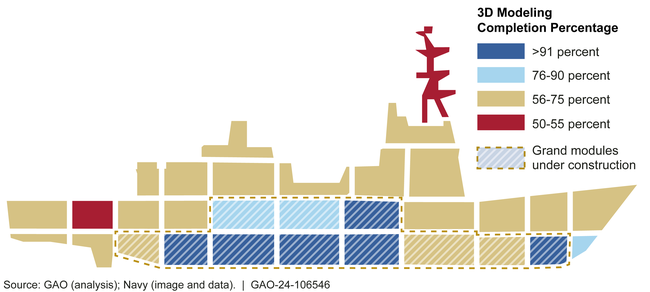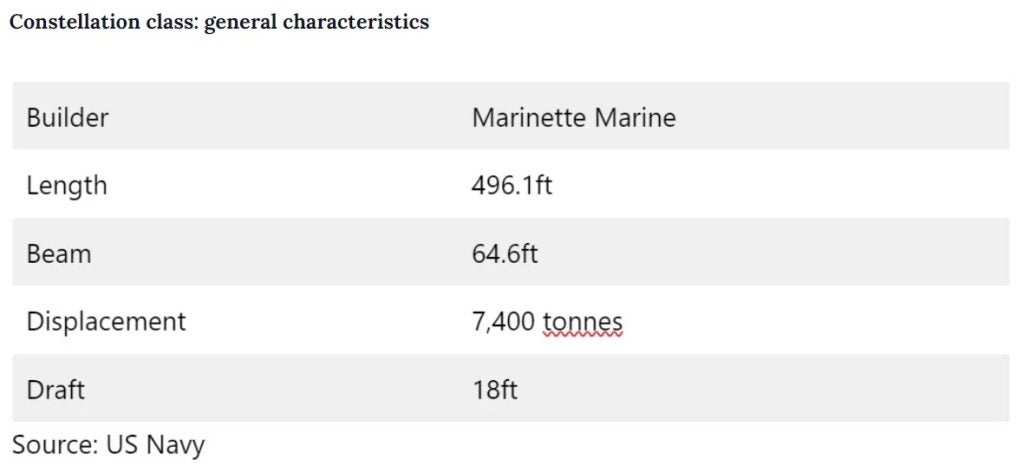
An excoriating report by the US Government Accountability Office (GAO) has said the build of the US Navy’s first Constellation-class frigate is “at a standstill” amid continued delays of a programme that sought to provide an effective solution to the woes of its Littoral Combat Ship (LCS) forebearer.
The Constellation class will be the first guided missile frigates (FFG) operated by the US Navy since the last of the Oliver Hazard Perry-class FFGs left service in 2015, which were intended, in part, to be replaced by the twin-variant LCS progamme.
However, the LCS programme was curtailed with some vessels decommissioned after just a handful of operational years following a series of setbacks for the type. Responding to this, the US Navy returned to the FFG concept as the lead element of its Small Surface Combatant force.
According to the US Congressional Research Service the US Navy began contracting for the Constellation class in 2020, with a total of six procured through FY24.
Despite this apparent progress, the GAO report into the Constellation programme, released on 29 May 2024, stated that the US Navy “undercut” a plan to reduce programme risks through the adoption of in-service capabilities that had been “proven” on other ships.
“Due to ongoing major design challenges, construction on the first ship is at a standstill. Now, the Navy forecasts the ship will be delivered three years late,” the GAO report stated.
How well do you really know your competitors?
Access the most comprehensive Company Profiles on the market, powered by GlobalData. Save hours of research. Gain competitive edge.

Thank you!
Your download email will arrive shortly
Not ready to buy yet? Download a free sample
We are confident about the unique quality of our Company Profiles. However, we want you to make the most beneficial decision for your business, so we offer a free sample that you can download by submitting the below form
By GlobalDataSpeaking with Naval Technology, Shelby Oakley, GAO’s director responsible for assessing Navy shipbuilding programmes, said that the GAO had previously reported the risks and acquisition challenges that concurrency in design and construction have caused on previous US Navy shipbuilding programmes.
“This is not a new issue for the Navy,” Oakley said.
Moreover, Oakley said the US Navy’s approach was “counter” to that taken by commercial shipbuilders when designing and building ships.
“These builders only begin construction when they have reached a stable design,” Oakley added.
Build of first Constellation frigate could take seven years
Providing a detailed background to the Constellation FFG programme, the GAO stated that over a span of two decades, the US Navy would acquire up to 20 FFGs at a combined cost of over $22bn, or a little over $1bn per vessel.
To reduce risk, the US Navy and shipbuilder Fincantieri Marinette Marine “modified an existing design” to incorporate service-specific weapon systems and specifications. However, the service’s decision to begin construction before the design was completed was “inconsistent with leading ship design practices and jeodardised this approach”, read the report.
Design instability has caused platform weight growth, the GAO stated, with the frigate’s 3D design incomplete over one year after construction began. The basic design of the Constellation FFG is taken from the Italian-French FREMM frigate, variants of which have been in service for a number of years.
Lead frigate 3D modeling progress by Grand Module, as of October 2023

A consequence of delays in completing ship design have created “mounting construction delays”, with the US Navy acknowledging that the planned April 2026 delivery date of first-in-class USS Constellation – which was set in the contract at the award – is unachievable.
The USS Constellation (FFG 62) is likely to be delayed by 36 months, meaning a delivery now scheduled for the April 2029 timeframe. Construction began on the ship in August 2022, meaning a more than seven-year span between manufacturing start and delivery.
Further, the GAO said that the programme office responsible for the Constellation-class FFG build saw its design stability metric hinged largely on the quantity, rather than quality, of completed design documents.
Should the US Navy begin construction on the second frigate with improving this metric, it risked “repeating the same errors” that led the construction disruptions and delays with the USS Constellation.

Asked about the US Navy’s intention to base the Constellation class on a European design, Oakley told Naval Technology that while the service claimed that the frigate would be based on the FREMM, the reality was that significant design changes resulted in the platform “more closely resembling” a new design.
“For example, the US Navy lengthened the ship by over 23 feet, redesigned the topside, integrated different hull plating, redesigned various distributive systems, and developed a new machinery control system,” the spokesperson said.
“Secondly, the Navy’s flawed design progress metrics overstated actual design stability. The Secretary of the Navy used these metrics to approve construction start on the lead ship, despite the design being incomplete even by the Navy’s own metrics.
“This ultimately gave the Navy and shipbuilder the green light to begin constructing ships while the design remained unstable.”
GAO: US Navy should adopt recommendations
Adding to the troubles of an instable frigate design and despite the deliberate use of mature mission technologies, the US Navy has also yet to demonstrate the propulsion and missions control systems, potentially opening up the class to further issues currently undiscovered when the vessels heads to sea for trials.
One solution, the GAO said, would be to conduct land-based testing of these two systems in order to reduce future risks.
In solution to the issued identified, the GAO recommended that the US Navy restructure its design stability metric to measure progress based more on the quality than quantity of design documents, incorporate additional land-based testing into the frigate test plan, and identify opportunities to further add leading practices for product development into the frigate acquisition strategy, among other suggestions.
“Until the lead ship design is complete, the Navy will not know if frigates will be capable of achieving the full set of capabilities. For example, the Navy disclosed to us in April 2024 that it is considering a reduction in the frigate’s speed requirement as one potential way, among others, to resolve the weight growth affecting the ship’s design,” Oakley stated.
It is unknown how quickly the US Navy could incorporate some, or all of the recommendations laid out by the GAO, with the programme pressing ahead with the funding for future vessels.
Earlier in May, Marinette Marine was awarded a more than $1bn fixed-price modification to exercise options for the detail design and construction of the next two Constellation-class guided missile frigates (FFG 66 and FFG 67) due to enter service with the US Navy.
This places six Constellation-class guided missile frigates under contract with the US Navy, with four now on option. The type will be delivered initially as a batch of ten vessels, which will be expanded to deliver a 20-ship class of frigates once completed.







